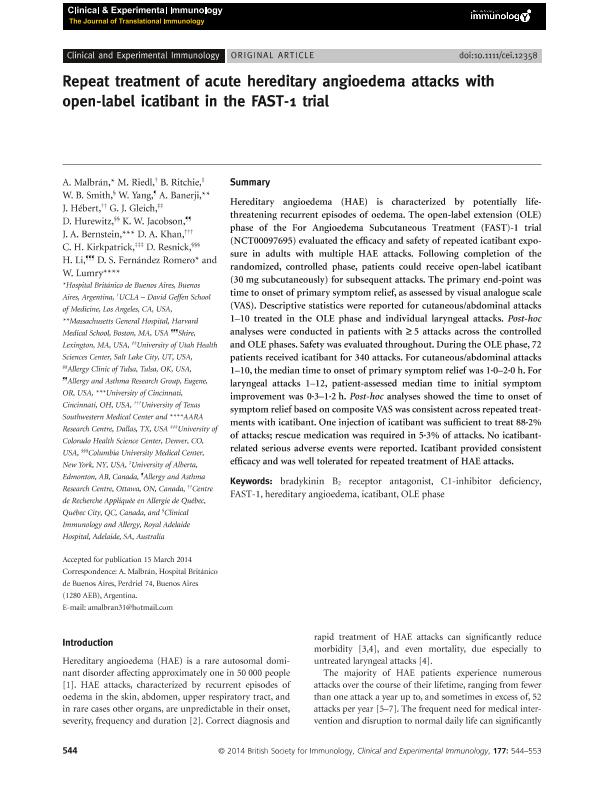Mostrar el registro sencillo del ítem
dc.contributor.author
Malbrán, Alejandro

dc.contributor.author
Riedl, M.
dc.contributor.author
Ritchie, B.
dc.contributor.author
Smith, W. B.
dc.contributor.author
Yang, W.
dc.contributor.author
Banerji, A.
dc.contributor.author
Hébert, J.
dc.contributor.author
Gleich, G. J.
dc.contributor.author
Hurewitz, D.
dc.contributor.author
Jacobson, K. W.
dc.contributor.author
Bernstein, J. A.
dc.contributor.author
Khan, D. A.
dc.contributor.author
Kirkpatrick, C. H.
dc.contributor.author
Resnick, D.
dc.contributor.author
Li, H.
dc.contributor.author
Fernández Romero, D. S.
dc.contributor.author
Lum, W.
dc.date.available
2018-01-23T18:21:31Z
dc.date.issued
2014-07
dc.identifier.citation
Malbrán, Alejandro; Riedl, M.; Ritchie, B.; Smith, W. B.; Yang, W.; et al.; Repeat treatment of acute hereditary angioedema attacks with open-label icatibant in the FAST-1 trial; Wiley; Clinical and Experimental Immunology; 177; 2; 7-2014; 544-553
dc.identifier.issn
0009-9104
dc.identifier.uri
http://hdl.handle.net/11336/34301
dc.description.abstract
Hereditary angioedema (HAE) is characterized by potentially lifethreatening recurrent episodes of oedema. The open-label extension (OLE) phase of the For Angioedema Subcutaneous Treatment (FAST)-1 trial (NCT00097695) evaluated the efficacy and safety of repeated icatibant exposure in adults with multiple HAE attacks. Following completion of the randomized, controlled phase, patients could receive open-label icatibant (30 mg subcutaneously) for subsequent attacks. The primary end-point was time to onset of primary symptom relief, as assessed by visual analogue scale (VAS). Descriptive statistics were reported for cutaneous/abdominal attacks 1–10 treated in the OLE phase and individual laryngeal attacks. Post-hoc analyses were conducted in patients with ≥ 5 attacks across the controlled and OLE phases. Safety was evaluated throughout. During the OLE phase, 72 patients received icatibant for 340 attacks. For cutaneous/abdominal attacks 1–10, the median time to onset of primary symptom relief was 1·0–2·0 h. For laryngeal attacks 1–12, patient-assessed median time to initial symptom improvement was 0·3–1·2 h. Post-hoc analyses showed the time to onset of symptom relief based on composite VAS was consistent across repeated treatments with icatibant. One injection of icatibant was sufficient to treat 88·2% of attacks; rescue medication was required in 5·3% of attacks. No icatibantrelated serious adverse events were reported. Icatibant provided consistent efficacy and was well tolerated for repeated treatment of HAE attacks.
dc.format
application/pdf
dc.language.iso
eng
dc.publisher
Wiley

dc.rights
info:eu-repo/semantics/openAccess
dc.rights.uri
https://creativecommons.org/licenses/by-nc-sa/2.5/ar/
dc.subject
Bradykinin B2 Receptor Antagonist
dc.subject
C1-Inhibitor Deficiency
dc.subject
Fast-1
dc.subject
Hereditary Angioedema
dc.subject
Icatibant
dc.subject
Ole Phase
dc.subject.classification
Medicina Critica y de Emergencia

dc.subject.classification
Medicina Clínica

dc.subject.classification
CIENCIAS MÉDICAS Y DE LA SALUD

dc.title
Repeat treatment of acute hereditary angioedema attacks with open-label icatibant in the FAST-1 trial
dc.type
info:eu-repo/semantics/article
dc.type
info:ar-repo/semantics/artículo
dc.type
info:eu-repo/semantics/publishedVersion
dc.date.updated
2018-01-23T17:20:42Z
dc.identifier.eissn
1365-2249
dc.journal.volume
177
dc.journal.number
2
dc.journal.pagination
544-553
dc.journal.pais
Estados Unidos

dc.journal.ciudad
Hoboken
dc.description.fil
Fil: Malbrán, Alejandro. Hospital Británico de Buenos Aires. Servicio de Alergia e Inmunología Clínica; Argentina. Consejo Nacional de Investigaciones Científicas y Técnicas; Argentina
dc.description.fil
Fil: Riedl, M.. University of California at Los Angeles; Estados Unidos
dc.description.fil
Fil: Ritchie, B.. University of Alberta; Canadá
dc.description.fil
Fil: Smith, W. B.. Royal Adelaide Hospital. Clinical Immunology and Allergy; Australia
dc.description.fil
Fil: Yang, W.. Allergy and Asthma Research Centre; Canadá
dc.description.fil
Fil: Banerji, A.. Harvard Medical School; Estados Unidos
dc.description.fil
Fil: Hébert, J.. Centre de Recherche Appliquée en Allergie de Québec; Canadá
dc.description.fil
Fil: Gleich, G. J.. University of Utah; Estados Unidos
dc.description.fil
Fil: Hurewitz, D.. Allergy Clinic of Tulsa; Estados Unidos
dc.description.fil
Fil: Jacobson, K. W.. Allergy and Asthma Research Group; Estados Unidos
dc.description.fil
Fil: Bernstein, J. A.. University of Cincinnati; Estados Unidos
dc.description.fil
Fil: Khan, D. A.. University of Texas. Southwestern Medical Center; Estados Unidos
dc.description.fil
Fil: Kirkpatrick, C. H.. University of Colorado. Health Science Center; Estados Unidos
dc.description.fil
Fil: Resnick, D.. Columbia University; Estados Unidos
dc.description.fil
Fil: Li, H.. Shire; Estados Unidos
dc.description.fil
Fil: Fernández Romero, D. S.. Hospital Británico de Buenos Aires; Argentina
dc.description.fil
Fil: Lum, W.. AARA Research Centre; Estados Unidos
dc.journal.title
Clinical and Experimental Immunology

dc.relation.alternativeid
info:eu-repo/semantics/altIdentifier/doi/http://dx.doi.org/10.1111/cei.12358
dc.relation.alternativeid
info:eu-repo/semantics/altIdentifier/url/http://onlinelibrary.wiley.com/doi/10.1111/cei.12358/abstract
Archivos asociados
